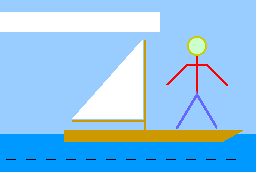Initializing Seaman for GameMaker
<<Previous | ToC
| Next >>
 At
this point in your development of Seaman you should have finished laying
out your widgets in GameMaker. Your picture does not need to look like
mine, but I will use mine for reference, and you may need to make adjustments
to accommodate your differences. Only the stick figure widgets and the
dash/letter text items will be referenced in your code -- unless you want
your boat to sail away when the seaman is fully on board, but we'll leave
that for after the game is working.
At
this point in your development of Seaman you should have finished laying
out your widgets in GameMaker. Your picture does not need to look like
mine, but I will use mine for reference, and you may need to make adjustments
to accommodate your differences. Only the stick figure widgets and the
dash/letter text items will be referenced in your code -- unless you want
your boat to sail away when the seaman is fully on board, but we'll leave
that for after the game is working.
In GameMaker, click the Build button, then quit (close the window).
In Replit the Seaman.java file that GameMaker made should already
be in your Repl. You probably did something like this if you made another
GameEngine program.
Your initialization goes in two places in the Seaman class window. Any
new class-wide variables you declare will go immediately before the first
"$" line, or (as I prefer) immediately after the second "$" line. Any other
initialization code goes inside the
Startup() method, preferably
after its second "$" line but before the closing brace.
The seaman's body parts need to be hidden as part of the initialization.
If you gave them Java-compatible names they are already declared for you,
all you need to do is (in the Startup() method) hide the eight
(or however many) widgets you have:
if (LefLeg != null) LefLeg.HideSho(false); // hide this
body part
if (RitLeg != null) RitLeg.HideSho(false); // ..and so on
The text dashes widgets could be hidden the same way, but later
code is much messier if you don't put them into an array that can be indexed
in a for-loop, so we do that as part of the initialization. First you need
to declare your persistent arrays, the word to be guessed as an array of
characters at the top of the class, after the second "$" line:
static char[] guessword = new char[32];
and an array of widgets:
static GameWgt[] dashes = new GameWgt[32];
The "static" shouldn't be necessary, but I found that (at least
in the version of BlueJ I was using) if you don't make these arrays
static, they get deleted between events. This kind of bug is typical
in unix programmers (see "Flat vs the Real World")
because they have little or no experience doing event-driven software.
They run the world, so get used to it.
From the initialization part of our English
program design, we see three other variables that need to persist across
events, so we declare them here too:
boolean playing = false;
int nLetts = 0, wrong = 0;
The English initialization code does not say much about how to "preset
the array ... dashes to be underscore characters '_' " but it
is, as we sometimes say ironically, "a simple matter of programming." For
one thing, the array is widgets, not characters. The widgets are already
declared with their own reference variables, we need to get those same
references into our array. If you defined them as I did, with the same
name differing only in the sequence number, then we can construct the names
on the fly in our for-loop, inside the Startup() method:
for (int nx=0; nx<32; nx++) {
 GameWgt
wgt = myGame.FindListWgt("{DashLet" + nx + "}");
GameWgt
wgt = myGame.FindListWgt("{DashLet" + nx + "}");
 if (wgt
!= null) {
if (wgt
!= null) {

 int zx = wgt.PutTextLn("_"); // set it to dash
int zx = wgt.PutTextLn("_"); // set it to dash

 wgt.HideSho(false);} // then
hide it
wgt.HideSho(false);} // then
hide it
 dashes[nx]
= wgt;} // end of for-loop
dashes[nx]
= wgt;} // end of for-loop
Of course I used my variable names, you need to use your own, whatever
names you used.
In the next page we'll build the Java code to play
the game.
<<Previous | ToC
| Next >>
[2022 November 8]
 At
this point in your development of Seaman you should have finished laying
out your widgets in GameMaker. Your picture does not need to look like
mine, but I will use mine for reference, and you may need to make adjustments
to accommodate your differences. Only the stick figure widgets and the
dash/letter text items will be referenced in your code -- unless you want
your boat to sail away when the seaman is fully on board, but we'll leave
that for after the game is working.
At
this point in your development of Seaman you should have finished laying
out your widgets in GameMaker. Your picture does not need to look like
mine, but I will use mine for reference, and you may need to make adjustments
to accommodate your differences. Only the stick figure widgets and the
dash/letter text items will be referenced in your code -- unless you want
your boat to sail away when the seaman is fully on board, but we'll leave
that for after the game is working.